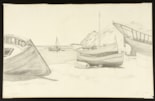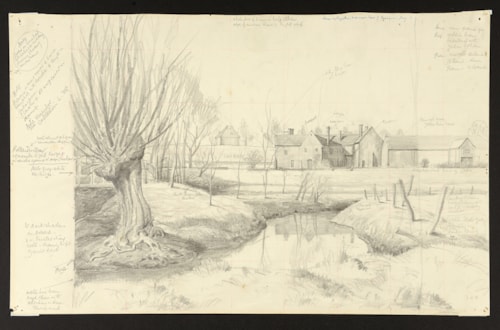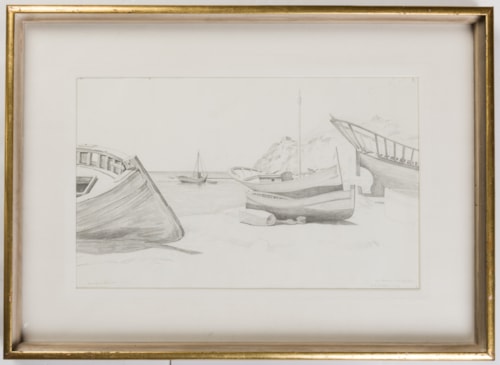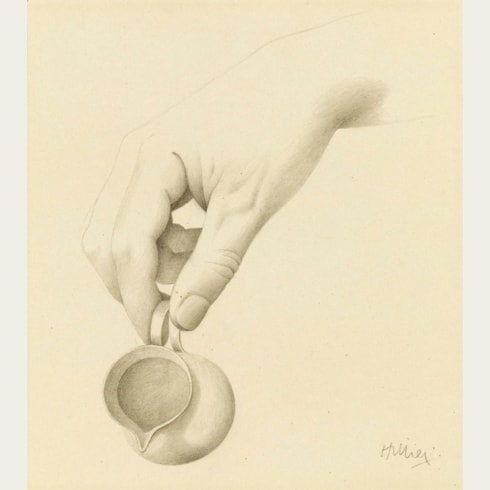Tristram Paul HILLIER
(Peking 1905 - Bristol 1983)
Fishing Boats on a Beach [recto], Landscape with Farm Buildings by a Stream [verso]
Sold
Pencil.
The verso in pencil, with the composition squared for transfer in red chalk.
Inscribed by the artist Numbers on lower boat in pencil at the lower left, and San Francisco (Numbers below) / AX AR/7 D ISABEL Y DIEGO in pencil at the lower right.
The verso extensively inscribed by the artist, in the margins, with various notes on composition, lighting and colour notes in pencil and blue ink.
289 x 457 mm. (11 3/8 x 18 in.) [sheet]
The verso in pencil, with the composition squared for transfer in red chalk.
Inscribed by the artist Numbers on lower boat in pencil at the lower left, and San Francisco (Numbers below) / AX AR/7 D ISABEL Y DIEGO in pencil at the lower right.
The verso extensively inscribed by the artist, in the margins, with various notes on composition, lighting and colour notes in pencil and blue ink.
289 x 457 mm. (11 3/8 x 18 in.) [sheet]
The landscape paintings and drawings for which Tristram Hillier is best known are characterized by a contemplative mood that is a particular hallmark of his work. Jenny Pery, the author of a recent monograph on the artist, has noted that, ‘Icily elegant, eerily still, Tristram Hillier’s work presents a dreamlike, post-apocalyptic world in which human beings, rarely seen on stage, seem to be refugees from disaster. Seashores with abandoned or rotting boats, foreign townscapes threaded by shadowed empty streets and overlooked by forlorn or forbidding churches, tree-lined country lanes where it is forever winter…these are the haunting images that furnished Hillier’s art throughout half a century of consistent production.’
Hillier’s finished paintings were preceded by detailed preparatory pencil studies, executed with a confidence and exactitude characteristic of all of his drawings. The recto of this large, double-sided sheet depicts a coastal view in Spain or Portugal. Hillier first visited the region the 1930s and returned almost yearly, usually in the summer, from the late 1940s through to the 1970s. In his autobiography, published in 1954, the artist wrote of Spain that it was ‘a country which I came subsequently to love above all countries and where, since the last war, I have worked for several months each year. The translucent light of the south is comparable to that of Greece…with the addition of a dramatic quality, both noble and cruel, with which the landscape as well as the people are invested. The Iberian peninsula is neither wholly European nor Asiatic in character, a land set apart from all others, but one pre-eminently to inspire a painter.’
On his summer visits to Spain and Portugal, Hillier would make intensely observed drawings and preparatory studies of the landscape and architecture, which he would later use as the basis for paintings completed in his studio in England. He was particularly attracted to the subject of fishing boats drawn up on deserted beaches. As Frances Spading has noted, ‘Boats in particular gave free play to Hillier’s sculptural feeling for form…the brightly coloured hull, with their strong, simple shapes, set up complex rhythms and satisfying interrelationships.’
The verso of the present sheet - extensively inscribed by the artist with detailed notes on colour, lighting and composition, and squared in red chalk - is a study for an English rural landscape, probably in Somerset, where the artist painted in the autumn and winter months. As Pery has written, ‘Although he grew to dislike the English countryside, he appreciated the quietude as well as many of the motifs it offered him – bare trees, muddy paths, frozen ponds.’5 As she further notes, ‘When he settled in Somerset after World War II, the steady habit of work that he adopted continued virtually until his death. During the winter months, the immaculate pencil drawings with which he returned from his annual summer wanderings would be worked up into paintings...The paintings became a synthesis of his experiences and feelings, emotion recollected in tranquility. In the cloistered environment of his studio he could relive his life through painting.’ Many of Hillier’s Somerset views were made in the countryside around his home in the village of East Pennard, between Shepton Mallet, Castle Cary and Glastonbury in the southeast corner of the county.
Writing shortly after the artist’s death, Nicholas Usherwood noted of Hillier’s paintings that, ‘Of Somerset or Spain, of boats on a beach or of buildings in a landscape, painted in 1936 or 1976, they all depend ultimately on the quality of still life and the disciplined concentration on a single theme: their secret life and impassive mystery…Tristram Hillier’s life may now sadly have come to an end but those boats still, expectantly, wait.’
More recently, in a review of a major exhibition of Hillier’s work held in 2019-2020, another critic has pointed out: ‘Look at his images of upturned boats, deserted seashores and industrial detritus, of wintry Somerset farms or the abandoned white villages of Spain. They are possessed by an aura of eerie quietude. Hillier can take any subject – a ship’s anchor, a tree bare of leaves, an electricity pylon, a broken-down barn – and impregnate it with a sense of otherworldly mystery. The mundane becomes enigmatic in his symbolic world.’
Hillier’s finished paintings were preceded by detailed preparatory pencil studies, executed with a confidence and exactitude characteristic of all of his drawings. The recto of this large, double-sided sheet depicts a coastal view in Spain or Portugal. Hillier first visited the region the 1930s and returned almost yearly, usually in the summer, from the late 1940s through to the 1970s. In his autobiography, published in 1954, the artist wrote of Spain that it was ‘a country which I came subsequently to love above all countries and where, since the last war, I have worked for several months each year. The translucent light of the south is comparable to that of Greece…with the addition of a dramatic quality, both noble and cruel, with which the landscape as well as the people are invested. The Iberian peninsula is neither wholly European nor Asiatic in character, a land set apart from all others, but one pre-eminently to inspire a painter.’
On his summer visits to Spain and Portugal, Hillier would make intensely observed drawings and preparatory studies of the landscape and architecture, which he would later use as the basis for paintings completed in his studio in England. He was particularly attracted to the subject of fishing boats drawn up on deserted beaches. As Frances Spading has noted, ‘Boats in particular gave free play to Hillier’s sculptural feeling for form…the brightly coloured hull, with their strong, simple shapes, set up complex rhythms and satisfying interrelationships.’
The verso of the present sheet - extensively inscribed by the artist with detailed notes on colour, lighting and composition, and squared in red chalk - is a study for an English rural landscape, probably in Somerset, where the artist painted in the autumn and winter months. As Pery has written, ‘Although he grew to dislike the English countryside, he appreciated the quietude as well as many of the motifs it offered him – bare trees, muddy paths, frozen ponds.’5 As she further notes, ‘When he settled in Somerset after World War II, the steady habit of work that he adopted continued virtually until his death. During the winter months, the immaculate pencil drawings with which he returned from his annual summer wanderings would be worked up into paintings...The paintings became a synthesis of his experiences and feelings, emotion recollected in tranquility. In the cloistered environment of his studio he could relive his life through painting.’ Many of Hillier’s Somerset views were made in the countryside around his home in the village of East Pennard, between Shepton Mallet, Castle Cary and Glastonbury in the southeast corner of the county.
Writing shortly after the artist’s death, Nicholas Usherwood noted of Hillier’s paintings that, ‘Of Somerset or Spain, of boats on a beach or of buildings in a landscape, painted in 1936 or 1976, they all depend ultimately on the quality of still life and the disciplined concentration on a single theme: their secret life and impassive mystery…Tristram Hillier’s life may now sadly have come to an end but those boats still, expectantly, wait.’
More recently, in a review of a major exhibition of Hillier’s work held in 2019-2020, another critic has pointed out: ‘Look at his images of upturned boats, deserted seashores and industrial detritus, of wintry Somerset farms or the abandoned white villages of Spain. They are possessed by an aura of eerie quietude. Hillier can take any subject – a ship’s anchor, a tree bare of leaves, an electricity pylon, a broken-down barn – and impregnate it with a sense of otherworldly mystery. The mundane becomes enigmatic in his symbolic world.’
Born in China, Tristram Hillier was trained at the Slade School of Art in London 1926 and at the Atelier Colarossi in Paris, and also spent some time in the studio of André Lhote. In Paris he met and befriended such artists as Georges Braque, André Masson and Max Ernst, and was drawn into the milieu of the Surrealists. He was active mainly as a landscape and still life painter, and also painted the occasional religious subject, all in a very precise manner with a high degree of finish. His paintings were preceded by detailed preparatory pencil drawings, executed with a confidence and exactitude that are characteristic of all of his drawings. He had his first one-man exhibition at the Lefevre Gallery in 1931, and in 1933 joined Paul Nash’s Unit One group, associating himself with the English Surrealists. Hillier lived in the South of France until the outbreak of the Second World War, after which he settled in Somerset, where he painted agricultural subjects with the same exactitude as his landscapes and still life subjects. Hillier exhibited widely in England and elsewhere, and was elected to the Royal Academy in 1957.
Tristram Hillier’s return to the Catholic faith of his childhood ensured that he remained deeply religious in his mature years. As he recalled in his autobiography, ‘One morning in a tawdry little chapel of a country town, I suddenly became aware with absolute certainty that the Miracle of the Mass which I was attending was not only true but was in fact no more remarkable than the existence of the little church itself or my own presence there…I had neither reasoned nor had I consciously prayed, but I knew at that moment and for some time afterwards a serenity of mind and a depth of happiness that I had never before imagined.’ Hillier’s religious convictions and deep spirituality was at times vividly expressed in his work.







